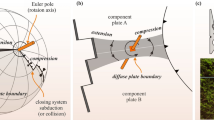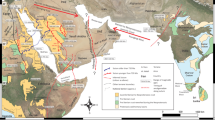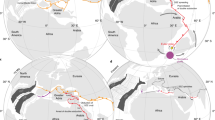Abstract
EARLIER this year we proposed a model for the evolution of the Middle East rift zones1. In this it was shown that the motion, of the three major crustal plates, Nubia, Somalia and Arabia, was such that it could be described as rotational about a single pole, the differing rates of rotation producing the intervening rift zones. In a criticism of this account, Roberts2 has proposed a modified model involving a three-plate, three-pole solution. This more general method should theoretically describe the motions of the plates more precisely than the one-pole, three-plate approximation which we adopted. The procedures and assumptions used by Roberts to determine the pole positions are, however, open to question, and hence his conclusions are of doubtful validity.
This is a preview of subscription content, access via your institution
Access options
Subscribe to this journal
Receive 51 print issues and online access
$199.00 per year
only $3.90 per issue
Buy this article
- Purchase on SpringerLink
- Instant access to full article PDF
Prices may be subject to local taxes which are calculated during checkout
Similar content being viewed by others
References
Gass, I. G., and Gibson, I. L., Nature, 221, 926 (1969).
Roberts, D. G., Nature, 223, 55 (1969).
Le Pichon, X., and Hertzler, J. R., J. Geophys. Res., 73, 6, 2101 (1968).
Morgan, W. J., J. Geophys. Res., 73, 1959 (1968).
Author information
Authors and Affiliations
Rights and permissions
About this article
Cite this article
GIBSON, I., GASS, I. Middle East Rift Zones. Nature 224, 791 (1969). https://doi.org/10.1038/224791a0
Received:
Issue date:
DOI: https://doi.org/10.1038/224791a0



